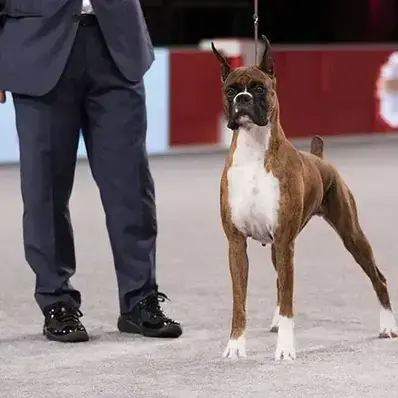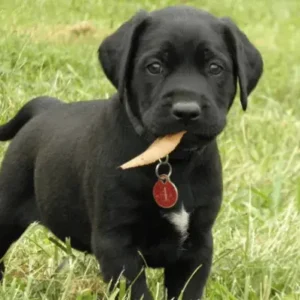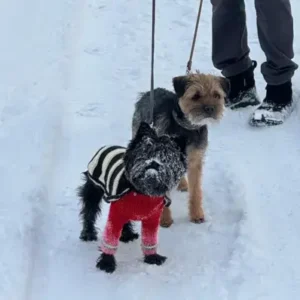Boxer History/Origin
The ancestors of the Boxer, the war dogs of the Assyrian empire, date back to around 2,500 B.C. However, the modern Boxer we know today emerged in Germany during the late 1800s and early 20th century. This breed evolved from the larger and heavier German Bullenbeisser (“bull biter”).
Boxers at the Boxer Club of Munich’s, Germany,1896- Source: American Bull and Terrier Kennel Club
In medieval times, the Bullenbeisser was Germany’s premier big-game hunter, used by noblemen to catch and hold formidable prey like bears, bison, and wild boars. By the early 1800s, political changes led to the decline of the German nobility, their estates, and their hunting traditions.
By 1865, the Bullenbeisser was nearly obsolete. It was crossed with a smaller mastiff-type breed from England to revive the breed, resulting in the sleeker and more elegant modern purebred Boxer.
Boxers in military work- Source: American Bull and Terrier Kennel Club
The name “Boxer” likely comes from the breed’s playful and defensive sparring with their front paws, reminiscent of a prizefighter. Over the years, they have served in various roles, including athlete, cattle dog, police dog, war dog (in both world wars), watchdog, protection dog, and guide dog for the blind.
The AKC registered its first Boxer in 1904, but the breed’s popularity in the U.S. soared in the 1950s when a Westminster-winning dog named Bang Away became a national celebrity. Since then, these dogs have consistently ranked among America’s top 10 most popular breeds.
The American Boxer Club (ABC) was formed in 1935. It gained acceptance by the AKC under Working Group in the same year. In the early days, there was a lot of controversy within the club about the Boxer standard. In 1938, the club finally approved a new standard.
Boxer Personality
The Boxer is one of the dog breeds that is vigilant “hearing” guard dog, dignified and self-assured when not being a clown. They are patient and playful with children, making them excellent family pets. Strangers are met with wariness, but they respond politely to friendly people. They display aggression only in defense of their family and home.
- Temperament
A blend of alertness, confidence, and playfulness marks the temperament of a Boxer. Known for their loyalty and protective nature, these dogs are excellent family companions who are patient and gentle with children. They are naturally wary of strangers but respond politely to friendly people, showing aggression only when defending their loved ones. Early socialization and training are vital in shaping their behavior, and helping them grow into well-rounded, friendly dogs.
- Potential Challenges
Boxers’ high energy and stubbornness can lead to jumping, pulling, and exuberance. Address this with consistent training and positive reinforcement. Use clicker training, provide regular exercise, and engage them with interactive toys to manage their energy.
Their need for mental and physical stimulation can cause chewing, digging, or barking. Provide chew toys, enrichment activities, and plenty of exercise to keep them occupied.
Boxers’ protective instincts may lead to over-protectiveness. Early socialization and obedience training are crucial to help them interact well with others and reduce territorial behavior.
Boxer Physical Appearance
The Boxer dog breed is a medium-sized, square-built dog with a smooth coat, characterized by strong bones and a robust yet agile appearance. Its muscles are well-developed and appear taut and sculpted, giving it a lively and powerful presence with a noble demeanor.
- Size
The Boxer typically stands between 21.5 to 25 inches tall at the shoulder and weighs approximately 65 to 80 pounds. This medium-sized breed is known for its athletic build, strong muscles, and distinctive square shape. They exude an energetic and alert presence, coupled with a noble and dignified bearing.
- Coat color
Boxers have a sleek, short coat that tightly fits their athletic bodies. They mainly come in fawn or brindle colors, sometimes with white markings. Fawn coats range from light tan to mahogany, while brindle coats show black stripes on a fawn background. White markings, if present, should cover less than one-third of their coat to avoid health issues like skin cancer and deafness.
Boxer Gender Differences
Boxers show minimal gender differences, with males and females typically sharing similar physical traits and temperament characteristics. These dogs maintain a consistent appearance and behavior across both sexes. They are known for their muscular build, alert expression, and playful demeanor, which are distinctive traits of the breed.
Boxer Feed/Nutrition
For an optimal Boxer diet, select high-quality dog food designed for medium-sized breeds with high energy levels, aiming for around 2.5 cups per day. Providing proper nutrition is key to promoting a long and healthy life.
Maintain a regular feeding schedule with two meals per day to prevent weight gain, and minimize treats while avoiding leaving food out all day. Pineapples can be a healthy treat if served in moderation, with the core and skin removed.
It’s important to follow your veterinarian’s advice on nutrition, as Boxers’ dietary requirements evolve from puppyhood through adulthood and into their senior years. Consult your vet for personalized recommendations based on factors such as weight, energy levels, and overall health.
Boxer Health
These dogs typically enjoy good health, but like all breeds, boxers are prone to certain medical conditions that prospective owners should be aware of. While not all dogs will develop these diseases, it’s important to be vigilant. Here are some health concerns to monitor and precautions to take:
- Arrhythmogenic right ventricular cardiomyopathy: ARVC is a genetic heart condition prevalent in Boxer dogs, characterized by the replacement of heart muscle with fatty or fibrous tissue in the right ventricle. This can lead to irregular heart rhythms and an increased risk of sudden cardiac events, such as fainting or sudden death. Monitoring heart function through routine vet visits and limiting strenuous activities can also help manage the condition. Providing a calm environment reduces stress on the heart.
- Aortic Stenosis/Sub-aortic Stenosis (AS/SAS): This heart condition involves a narrowing of the aorta below the aortic valve, restricting blood flow from the heart. Diagnosis typically involves detecting a heart murmur and affected Boxers should be evaluated by a veterinary cardiologist. In severe cases, surgical procedures may be necessary to widen the narrowed area, and consulting a veterinary cardiologist is recommended for specialized care.
- Hip Dysplasia: This hereditary condition results from a malformed hip joint, causing pain, lameness, and arthritis over time. X-rays can diagnose hip dysplasia, and affected dogs may benefit from weight management, joint supplements, or surgical intervention. For severe cases, surgical options such as hip replacement may be required, and consulting an orthopedic specialist can provide personalized treatment.
- Corneal Dystrophy: This genetic condition affects the cornea, causing cloudy or opaque spots that can impair vision. While not typically painful, regular eye exams can monitor progression. Treatment focuses on managing symptoms and maintaining eye health.
- Canine Gastric Torsion: This life-threatening condition occurs when a dog’s stomach fills with gas and twists on itself. It requires immediate veterinary intervention to relieve pressure and restore blood flow. Preventive measures include feeding smaller, more frequent meals and avoiding vigorous exercise immediately after eating. Some owners choose a preventive procedure called gastropexy, where the stomach is surgically attached to the abdominal wall to prevent twisting.
By implementing these management and treatment strategies, Boxer owners can address common health concerns and help ensure their pets lead a healthier and more comfortable life.
Boxer Care and Grooming
Boxers are known for their short-haired coat. Their coat is smooth and lies close to the body, requiring minimal grooming compared to longer-haired breeds. Regular grooming is straightforward, requiring just weekly brushing to manage shedding.
Brushing their teeth regularly prevents dental problems while trimming nails every few weeks maintains their paw health. Introducing grooming routines early in puppyhood helps them grow accustomed to handling, ensuring positive vet visits.
Regular grooming also allows for health checks, identifying any issues early for prompt treatment.
In addition to grooming, Boxers have high exercise needs. They are an energetic breed that thrives on regular physical activity, requiring daily exercise to stay healthy and happy. A combination of walks, playtime, and mental stimulation helps keep them fit and prevents behavioral issues that can arise from boredom or excess energy.
Introducing grooming and exercise routines early in puppyhood helps Boxers grow accustomed to handling and ensures positive vet visits. Crate training your dog from a young age can also create a safe, comfortable space for them and aid in house training.
Boxer Rescue Groups
Rescue groups specialize in finding new homes for Boxers who need them. They rescue dogs from shelters and other tough situations, providing medical care and rehabilitation. Through fostering, they prepare dogs for adoption, ensuring they find loving families suited to their needs.
Boxer Price
The price of a Boxer typically ranges from $800 to $2,500, depending on factors such as breeder reputation, pedigree, and location.
Boxer puppies and dogs are often available for sale through reputable breeders who prioritize health and temperament. It’s important to choose a breeder who conducts health screenings and provides a clean, caring environment for their dogs.
Interesting Facts
- The Boxer has achieved Best in Show at the Westminster Kennel Club Dog Show on four occasions: in 1947, 1949, 1951, and 1970.
- Humphrey Bogart and Lauren Bacall were gifted their first Boxer, Harvey, as a wedding present.
Harvey- Source: Another Magazine
- Kim Kardashian has owned a Boxer.
Kim Kardashian with her Boxer- Source: Pinterest
Best For
Boxers are best suited for individuals and families who lead active lifestyles and can provide ample exercise and mental stimulation. They thrive in homes where they receive regular companionship and interaction. Boxers are known for their loyalty, playfulness, and protective nature, making them excellent companions for those seeking a devoted and energetic pet.
Top Names
| Male Boxer Names | Female Boxer Names |
| Rocky | Bella |
| Tyson | Luna |
| Diesel | Daisy |
| Max | Roxy |
| Bruno | Ruby |









 Boxers at the Boxer Club of Munich’s, Germany,1896- Source:
Boxers at the Boxer Club of Munich’s, Germany,1896- Source:  Boxers in military work- Source:
Boxers in military work- Source: 

 Brindle Boxer – Source:
Brindle Boxer – Source:  Brown Boxer-Source:
Brown Boxer-Source:  Fawn Boxer- Source:
Fawn Boxer- Source: 
 Harvey- Source:
Harvey- Source:  Kim Kardashian with her Boxer- Source:
Kim Kardashian with her Boxer- Source: 






